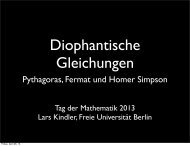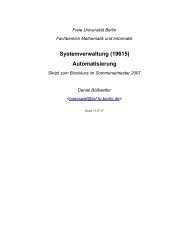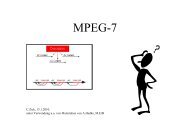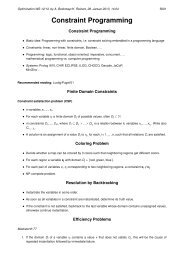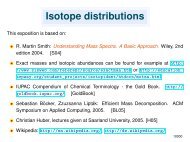Linear Algebra
Linear Algebra
Linear Algebra
Create successful ePaper yourself
Turn your PDF publications into a flip-book with our unique Google optimized e-Paper software.
Dr. Gunnar W. Klau<br />
Abdelhalim Larhlimi<br />
Institut für Mathematik II<br />
AG Mathematik in den Lebenswissenschaften<br />
<strong>Linear</strong> <strong>Algebra</strong><br />
We recall some basic definitions from linear algebra.<br />
• A vector x ∈ R n is a linear combination of the vectors x 1 , . . . , x p ∈ R n if<br />
x =<br />
p<br />
λix i , for some λ1, . . . , λp ∈ R<br />
i=1<br />
• If in addition, λ1, . . . , λp = 1, x is an affine combination of x 1 , . . . , x p .<br />
• For X ⊆ R n , X = ∅, the linear (resp. affine) hull of X, denoted by lin(X) (resp.<br />
aff(X)), is the set of all linear (resp. affine) combinations of finitely many vectors<br />
of X.<br />
• A set X ⊆ R n , X = ∅, is called linearly independent (resp, affinely independent) if<br />
no vector x ∈ X is expressible as a linear (resp. affine) combination of the vectors<br />
in X \ {x}, otherwise X is called linearly dependent (resp. affinely dependent).<br />
• The rank (resp affine rank) of X, denoted by rank(X) (resp arank(X)), is the<br />
cardinality of the largest linearly (resp. affinely) independent subset of X.<br />
• If 0 ∈ aff(X) then arank(X) = rank(X) + 1, otherwise arank(X) = rank(X).<br />
• By definition, the dimension of a set X ⊆ R n is the maximum number of<br />
affinely independent vectors in X minus one, i.e., dim(X) = arank(X) − 1.<br />
• If 0 ∈ aff(X) then dim(X) = rank(X), otherwise dim(X) = rank(X) − 1.<br />
Example:<br />
Let<br />
P = {x ∈ R 2 | 0 ≤ x1 ≤ 1},<br />
F1 = P ∩ {x ∈ R 2 | x1 = 0},<br />
F2 = P ∩ {x ∈ R 2 | x1 = 1}.
We have<br />
Hint:<br />
aff(P ) = R 2 ,<br />
aff(F1) = {x ∈ R 2 | x1 = 0},<br />
aff(F2) = {x ∈ R 2 | x1 = 1}.<br />
• We can easily see that the vectors (1, 0) T ∈ P and (0, 1) T ∈ P are linearly in-<br />
dependent in P . Therfeore, rank(P ) = 2. Since 0 ∈ aff(P ), we have dim(P ) =<br />
rank(P ) = 2 (P is full-dimensional).<br />
• F1 and F2 are two faces of P defined by the valid inequalities 0 ≤ x1 and x ≤ 1,<br />
respectively.<br />
• No other vector in F1 is linearly independent of the vector (0, 1) T ∈ F1. Then,<br />
rank(F1) = 1. Since 0 ∈ aff(F1), we have dim(F1) = rank(F1) = 1.<br />
• We can easily see that the vectors (1, 0) T ∈ F2 and (1, 1) T ∈ F2 are linearly<br />
independent in F2. Therefore, rank(F2) = 2. Since 0 /∈ aff(F2), we have dim(F2) =<br />
rank(F2) − 1 = 1.<br />
For a given set of vectors x 1 , . . . , x p ∈ R n , they are linearly independent if<br />
only when λ1 = λ2 = . . . , = λp = 0.<br />
λ1x 1 + λ2x 2 + . . . , +λpx p = 0





